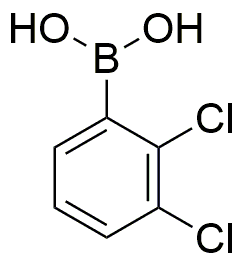2,3-Dichlorophenylboronic acid is widely utilized in research focused on:
- Organic Synthesis: This compound serves as a key building block in the synthesis of various organic molecules, particularly in the development of pharmaceuticals and agrochemicals, enhancing efficiency in creating complex structures.
- Medicinal Chemistry: It plays a significant role in drug discovery, especially in the design of inhibitors for certain enzymes, which can lead to the development of new therapeutic agents for diseases such as cancer.
- Material Science: Used in the preparation of boron-containing polymers, it contributes to the development of advanced materials with improved properties, such as enhanced thermal stability and mechanical strength.
- Bioconjugation: The compound is effective in bioconjugation processes, allowing researchers to attach biomolecules to surfaces or other molecules, which is crucial for creating targeted drug delivery systems.
- Analytical Chemistry: It is utilized in the development of sensors and analytical methods for detecting specific biomolecules, providing a reliable approach for monitoring various biological processes.
General Information
Properties
Safety and Regulations
Applications
2,3-Dichlorophenylboronic acid is widely utilized in research focused on:
- Organic Synthesis: This compound serves as a key building block in the synthesis of various organic molecules, particularly in the development of pharmaceuticals and agrochemicals, enhancing efficiency in creating complex structures.
- Medicinal Chemistry: It plays a significant role in drug discovery, especially in the design of inhibitors for certain enzymes, which can lead to the development of new therapeutic agents for diseases such as cancer.
- Material Science: Used in the preparation of boron-containing polymers, it contributes to the development of advanced materials with improved properties, such as enhanced thermal stability and mechanical strength.
- Bioconjugation: The compound is effective in bioconjugation processes, allowing researchers to attach biomolecules to surfaces or other molecules, which is crucial for creating targeted drug delivery systems.
- Analytical Chemistry: It is utilized in the development of sensors and analytical methods for detecting specific biomolecules, providing a reliable approach for monitoring various biological processes.
Documents
Safety Data Sheets (SDS)
The SDS provides comprehensive safety information on handling, storage, and disposal of the product.
Product Specification (PS)
The PS provides a comprehensive breakdown of the product’s properties, including chemical composition, physical state, purity, and storage requirements. It also details acceptable quality ranges and the product's intended applications.
Certificates of Analysis (COA)
Search for Certificates of Analysis (COA) by entering the products Lot Number. Lot and Batch Numbers can be found on a product’s label following the words ‘Lot’ or ‘Batch’.
*Catalog Number
*Lot Number
Certificates Of Origin (COO)
This COO confirms the country where the product was manufactured, and also details the materials and components used in it and whether it is derived from natural, synthetic, or other specific sources. This certificate may be required for customs, trade, and regulatory compliance.
*Catalog Number
*Lot Number
Safety Data Sheets (SDS)
The SDS provides comprehensive safety information on handling, storage, and disposal of the product.
DownloadProduct Specification (PS)
The PS provides a comprehensive breakdown of the product’s properties, including chemical composition, physical state, purity, and storage requirements. It also details acceptable quality ranges and the product's intended applications.
DownloadCertificates of Analysis (COA)
Search for Certificates of Analysis (COA) by entering the products Lot Number. Lot and Batch Numbers can be found on a product’s label following the words ‘Lot’ or ‘Batch’.
*Catalog Number
*Lot Number
Certificates Of Origin (COO)
This COO confirms the country where the product was manufactured, and also details the materials and components used in it and whether it is derived from natural, synthetic, or other specific sources. This certificate may be required for customs, trade, and regulatory compliance.


